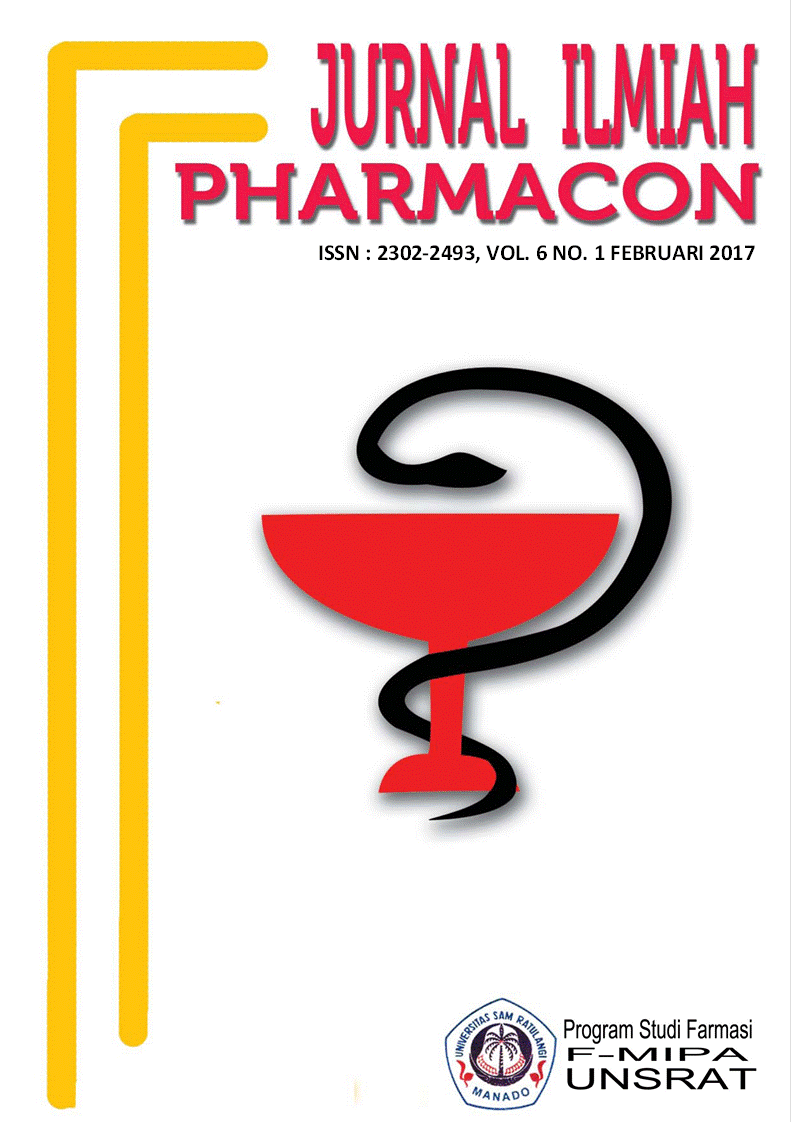UJI DAYA HAMBAT EKSTRAK DAUN KEMBANG SEPATU ( Hibiscus rosa-sinensis L. ) TERHADAP PERTUMBUHAN BAKTERI Porphyromonas gingivalis SECARA IN VITRO
DOI:
https://doi.org/10.35799/pha.6.2017.15002Abstract
UJI DAYA  HAMBAT EKSTRAK DAUN KEMBANG SEPATU ( Hibiscus rosa-sinensis L. ) TERHADAP PERTUMBUHAN BAKTERI Porphyromonas gingivalis SECARA IN VITRO
Jessica Lesly Tamboto1), Â Heriyannis Homenta2), Â Juliatri1)
1Program Studi Pendidikan Dokter Gigi Fakultas Kedokteran, UNSRAT Manado, 95115
2Bagian Mikrobiologi Fakultas Kedokteran, UNSRAT Manado, 95115
Â
ABSTRACT
Hibiscus plant (Hibiscus rosa-sinensis L.) known as ornamental plants but widely used as medicinal plant. Hibiscus leaves contain a variety of antibacterial compounds such as alkaloids, glycosides, flavonoids, tannins, phenols and sapponin. Periodontitis is a disease caused by bacterial infection such as Porphyromonas gingivalis that occurs in the gingiva and tooth supporting tissues with the clinical picture in the form of chronic inflammation of the gingiva, periodontal tissue destruction, alveolar bone loss, formation of periodontal pockets and tooth loss. The purpose of this study to determine the inhibiting of hibiscus leaves to the growth of Porphyromonas gingivalis bacteria as the caused of periodontitis by measuring the diameter of the resulting inhibition zone. This study was an experimental study with Kirby-bauer modified method using disk. Hibiscus leaves were extracted by maceration method using ethanol 96% as a solvent. The results showed with average diameter value of the inhibition zone that produced by hibiscus leaves extract in five petri dishes are 9.7 mm. It can be concluded that Hibiscus leaves extract can inhibite the growth of Porphyromonas gingivalis bacteria.
Keywords: Hibiscus plant, Porphyromonas gingivalis, periodontitis, inhibition zone
ABSTRAK
Tanaman kembang sepatu (Hibiscus rosa-sinensis L.) merupakan tanaman yang dikenal sebagai tanaman hias namun banyak dimanfaatkan sebagai tanaman obat. Daun kembang sepatu mengandung berbagai senyawa yang bersifat antibakteri seperti alkaloid, glikosida, flavonoid, tanin, fenol dan saponin. Periodontitis merupakan penyakit akibat infeksi bakteri di antaranya Porphyromonas gingivalis yang terjadi di daerah gingiva dan jaringan pendukung gigi dengan gambaran klinis berupa inflamasi kronis pada gingiva, desktruksi jaringan periodontal, kehilangan tulang alveolar, terbentuknya poket periodontal, gigi goyang dan gigi tanggal. Tujuan penelitian ini untuk mengetahui daya hambat daun kembang sepatu terhadap pertumbuhan bakteri Porphyromonas gingivalis penyebab periodontitis dengan mengukur diameter zona hambat yang dihasilkan. Penelitian ini merupakan penelitian eksperimental dengan metode modifikasi Kirby-bauer menggunakan disk/cakram. Daun kembang sepatu diekstraksi dengan metode maserasi dan menggunakan etanol 96% sebagai pelarut. Hasil penelitian menunjukkan nilai rata-rata diameter zona hambat yang dihasilkan ekstrak daun kembang sepatu pada lima cawan petri sebesar  9,7 mm. Dapat disimpulkan bahwa ekstrak daun kembang sepatu memiliki daya hambat terhadap pertumbuhan bakteri Porphyromonas gingivalis.
Â
Kata kunci: Kembang sepatu, Porphyromonas gingivalis, periodontitis, zona hambat
Â
Downloads
Published
How to Cite
Issue
Section
License
Authors who publish with this journal agree to the following terms:
- Authors retain copyright and grant the journal right of first publication with the work simultaneously licensed under a Creative Commons Attribution-NonCommercial 4.0 International License that allows others to share the work with an acknowledgement of the work's authorship and initial publication in this journal.
- Authors are permitted and encouraged to post their work online (e.g., in institutional repositories or on their website) prior to and during the submission process, as it can lead to productive exchanges, as well as earlier and greater citation of published work (See The Effect of Open Access)










